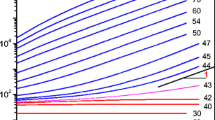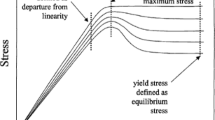Abstract
The yielding of several reversible yield stress fluids is studied during scissometric-like creep experiments. The temporal evolution of the apparent deformation is recorded for applied stresses close and below the usual yield stress. Similarly to solids, three main creep regimes are observed. First, a primary creep regime displaying a temporal power law evolution of the deformation rate occurs, followed by a temporal minimum, which leads to an apparent flow of the material. This local minimum, defined as the “transition time,” and the subsequent fluidization can be observed at long times. The evolution of this time as a function of the applied stress appears to follow a universal law reminiscent of fracture behavior in hard solids.






Similar content being viewed by others
References
Andrade EC (1910) The viscous flow in metals, and allied phenomena. Proc R Soc Lond A 84:1–12
Baravian C, Benbelkacem G, Caton F (2007) Unsteady rheometry: can we characterize weak gels with a controlled stress rheometer? Rheol Acta 46:577–581
Barnes H (1999) The yield stress—a review or ‘panta rei’ everything flows? J Non-Newton Fluid Mech 81:133–178
Bauer T, Oberdisse J, Ramos L (2006) Collective rearrangement at the onset of flow of a polycrystalline hexagonal columnar phase. Phys Rev Lett 97:258303
Bayoda E, Willers EP, Tornberg E (2007) Rheological and structural characterization of tomato paste and its influence on the quality of ketchup. Food Sci Tech doi:10.1016/j.lwt.2007.08.011
Bhattacharya S, Vasudha N, Murthy KK (1999) Rheology of mustard paste: a controlled stress measurement. J Food Eng 41:187–191
Coussot P, Tabuteau H, Chateau X, Tocquer L, Ovarlez G (2006) Aging and solid or liquid behavior in pastes. J Rheol 50:975–994
Lawn B (1993) Fracture of brittle solids. Cambridge solid state science series. Cambridge University Press, Cambridge
Nechad H, Helmstetter A, Guerjouma RE, Sornette D (2005) Creep ruptures in heterogeneous materials. Phys Rev Lett 94:045501
Persello J, Magnin A, Chang J, Piau J, Cabannes B (1994) Flow of colloidal aqueous silica dispersions. J Rheol 38:1845
Piau J (2007) Carbopol gels: elastoviscoplastic and slippery glasses made of individual swollen sponges meso- and macroscopic properties, constitutive equations and scaling laws. J Non-Newton Fluid Mech 144:1–29
Pomeau Y (1992) Spontaneous breaking of two dimensional bent crystals. CRAS Serie II 314:553
Pomeau Y (2002) Fundamental problems in brittle fracture: unstable cracks and delayed breaking. CR Mecanique 330:249
Acknowledgements
We acknowledge fruitful discussions with Philippe Marchal and Daniel Quemada.
Author information
Authors and Affiliations
Corresponding author
Rights and permissions
About this article
Cite this article
Caton, F., Baravian, C. Plastic behavior of some yield stress fluids: from creep to long-time yield. Rheol Acta 47, 601–607 (2008). https://doi.org/10.1007/s00397-008-0267-2
Received:
Revised:
Accepted:
Published:
Issue Date:
DOI: https://doi.org/10.1007/s00397-008-0267-2




